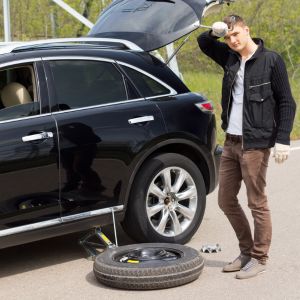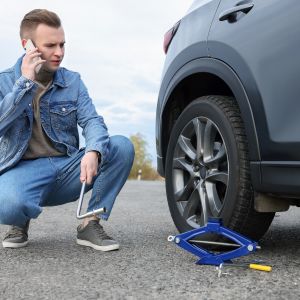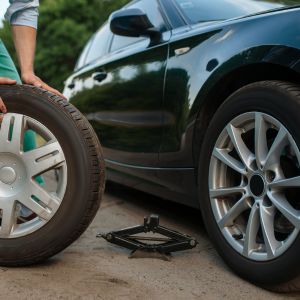As a car owner, it is important to regularly check your vehicle’s tyres for any signs of damage, especially punctures. Driving with a punctured tyre can not only lead to a potential safety hazard, but it can also result in costly repairs or replacements. Therefore, it is crucial to know how to properly check for punctures in your rear car tyres to ensure optimal performance and longevity. This article will provide a comprehensive guide on how to effectively inspect and detect punctures in your tyres.
From identifying common signs of puncture to conducting a thorough inspection, this article will equip you with the necessary knowledge and skills to keep your rear tyres in top condition. So, whether you are a new car owner or simply want to brush up on your maintenance skills, read on to discover the essential steps in checking for punctures in your rear car tyres. By following these simple guidelines, you can ensure the safety of yourself and others on the road, as well as save yourself from potential expenses in the long run.
Inspect tyres regularly for punctures

Regularly inspecting your car’s tyres for punctures is an essential part of maintaining road safety and prolonging the lifespan of your tyres. As a responsible driver, it is crucial to prioritize tyre maintenance to prevent any unexpected mishaps on the road. By conducting routine visual inspections, you can identify any signs of punctures such as nails, screws, or other sharp objects lodged in the tyre tread.
Additionally, it is advisable to run your hands over the tyre surface to feel for any unusual bulges or cuts, as they could indicate a puncture or potential tyre damage. Promptly addressing any punctures or damages will not only ensure your safety but also prevent further deterioration of your rear car tyres.
Look for visible damage or leaks

During the process of checking for punctures in rear car tyres, it is important to thoroughly examine the tyres for any visible damage or leaks. Inspect the tyre sidewalls and tread for any signs of cuts, slashes, or bulges, as these could indicate a potential puncture. Look for any objects embedded in the tyre, such as nails or screws, which may have caused the puncture.
Additionally, check for any signs of leaks, such as visible air escaping or a hissing sound when pressing on the tyre. Identifying and addressing visible damage or leaks promptly can prevent further damage to the tyre and ensure optimal performance and safety on the road.
Use a pressure gauge to check for low air

To ensure the proper maintenance and safety of your rear car tyres, it is essential to regularly check for low air pressure. Using a pressure gauge is a reliable method to accurately measure the air pressure in your tyres. Begin by unscrewing the valve cap from the tyre valve stem. Firmly attach the pressure gauge to the valve stem and press down until the gauge provides a reading.
Compare the measured pressure with the recommended pressure level specified by the vehicle manufacturer. If the reading shows lower air pressure than recommended, it is crucial to inflate the tyre to the appropriate level to prevent potential hazards such as decreased fuel efficiency, uneven tyre wear, and compromised handling. Regularly checking for low air pressure using a pressure gauge is an important step in maintaining the overall health and performance of your rear car tyres.
Rotate tyres for even wear
To ensure even wear and prolong the lifespan of your rear car tyres, it is highly recommended to regularly rotate them. Tyre rotation involves moving the tyres from one position on the vehicle to another, such as swapping the rear tyres with the front tyres. This practice helps distribute the wear and tear more evenly across all tyres, as the front tyres tend to wear out faster due to steering and braking forces.
By rotating the tyres, you can optimize their performance and ensure a smoother and safer driving experience. It is advised to follow the specific rotation pattern recommended by the vehicle manufacturer, which can usually be found in the owner’s manual or obtained from a certified mechanic. Regularly rotating your tyres is a proactive measure that can save you money in the long run by maximizing their longevity and avoiding the need for premature replacements.
Seek professional help if unsure
If you encounter any uncertainty or difficulty while attempting to check for a puncture in your rear car tyres, seek professional help without hesitation. Trained and experienced mechanics possess the knowledge and expertise necessary to accurately diagnose and address any issues with your tyres. They have access to specialized tools and equipment that can effectively identify punctures and determine the best course of action for repair or replacement.
Additionally, relying on professional assistance ensures that the job is carried out with precision, minimising the risk of further damage or incorrect diagnosis. Remember, prioritizing your safety and the optimal performance of your vehicle should always be the top priority, and seeking professional help is a prudent decision when in doubt.
FAQs About puncture in rear car tyres
What are some visual signs to look for when checking for punctures in rear car tyres?
Some visual signs to look for when checking for punctures in rear car tyres include a visible hole or tear in the tyre tread or sidewall, a bulge or blister on the tyre surface, a nail or foreign object embedded in the tyre, or a sudden loss of air pressure. Additionally, if you notice uneven or abnormal wear patterns on the tyre, it may indicate a potential puncture or other damage. It is important to inspect the tyres regularly and address any signs of punctures promptly to ensure optimal safety and performance.
How can I use a pressure gauge to check for punctures in my rear car tyres?
To check for punctures in your rear car tyres using a pressure gauge, start by removing the valve cap on each tyre. Then, attach the pressure gauge onto the valve stem and press firmly to get an accurate reading of the tyre pressure. If the pressure is significantly lower than the recommended level, it may indicate a puncture. Next, visually inspect the tyre for any visible signs of punctures, such as nails or screws embedded in the tread. Additionally, you can listen for any hissing sounds that could indicate air leakage. If you suspect a puncture, it is recommended to have a professional inspect and repair the tyre.
Are there any specific sounds or noises that may indicate a puncture in the rear car tyres?
Yes, there are specific sounds or noises that may indicate a puncture in the rear car tyres. These may include a hissing or whistling sound coming from the tyre, a thumping or flapping noise while driving, or a sudden decrease in tire pressure. It is important to pay attention to these sounds and inspect the tyres immediately if you suspect a puncture, as driving on a punctured tyre can be dangerous and lead to further damage.
Conclusion
Being able to properly check for punctures in your car’s rear tyres is an important skill for any driver. By following these steps and regularly checking your tyres, you can ensure your safety on the road and prevent any potential accidents. Remember to always take precautionary measures and seek professional assistance if needed. With proper maintenance, you can keep your tyres in top condition and extend their lifespan. By staying vigilant and taking care of your car’s tyres, you can have a smoother and safer driving experience.

